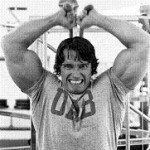When it comes to packing on some size in the form of muscle gain, there is one component of working out that simply cannot be ignored. We all want gym results, but it should be obvious to anybody who works out that those gym results require hard work. Excluding the discussion on diet and focusing solely on the time spent in the gym, what exactly is “hard work”? Well, if you didn’t get it from the title of this article you’ll certainly know now, progressive overload. Sounds scientific? Not really, once we get past the fancy words. However, before we dive into that, let’s quickly summarize how the process of muscle gain works in three simple steps.
1. We do a set of exercises focused on stressing a particular muscle group.
2. Our body reacts to this new stress by building up that muscle group so that it can handle that stress again.
3. We do a set of exercises focused on stressing that particular muscle group again. (and the cycle repeats)
Pretty simple, right? Well, what is the difference between step 1 and step 3? Step 3 is where progressive overload comes into play and is absolutely essential if you want to increase muscle size. I may be speaking to the choir, but you’d be surprised at how many people get this wrong. Let’s break this phrase down before we tackle why that is.
Progressive – continued increase
Overload – stress
What does that give us? Continued increase in stress. Let’s use chest as an example.
You come into the gym with a set routine to workout chest, you perform that routine, your chest feels tired, and you recover long enough to come back into the gym and do it again. The key, however, is to improve in your routine in one form or another so that you are taxing your chest at least slightly more than you were the previous time you worked it out. It’s actually quite simple to understand using the process described above. At first, your chest gets stressed and your body initiates a signal to make it stronger (by growing it) so that it can handle that same stress next time. However, this means that the next time you stress your chest in the gym, you’re going to have to stress it harder than the time before because your body has already adopted to the stress caused by your previous day training chest. Where will working out the same leave you? With no progress.
Think of it as a game of cat and mouse. Let your body be the cat, chasing your mousy workouts. Sounds corny, but it gets the point across. You can never stagnate and stress your muscle group the exact same way you did the last time you worked it, or the cat will have caught the mouse and made that new gym session pretty much pointless. In order to achieve muscle gain, you have to increase the stress brought upon each body part with each workout for your body to react and grow that body part bigger to handle that new stress. If you simply tax your body part the same as you did before, your body has no initiative to increase in size because the stress upon it has already been attended to from your previous workout.
That is why this is one of the most important muscle gain tips you’ll come across, even though it technically sounds like a no-brainer. I see so many people in the gym working out a body part, but looking like they are lifting casually. That is simply a waste of time. If you’re not pushing your body part to the limit you’re not going to get anywhere. Each week the limit should be higher, to account for your body’s adoption to the stress you caused it on the previous workout. That is the whole concept of progressive overload. Muscle gain is not possible without it.
The most common way to ensure progressive overload is to simply improve on a rep count each time you work out a body part. If last week you benched 185×5, this week strive for 185×6. Some weeks you might be able to jump 2 reps, others you might stay the same but increase on another lift for that body part. Remember, if you’re doing 4 exercises for chest that doesn’t mean you have to improve on each and every one. You certainly should strive to, but improving on at least one while keeping the others the same is already better than your previous workout, and that’s all we’re looking for. It really depends on your body and your diet how much you’ll be able to improve from week to week. Of course, if you wish to get anywhere in terms of muscle gain you’re going to have to make sure you’re above your maintenance calories amount so always keep that in mind. In terms of your workouts, however, make sure you always improve from your previous gym session, that is the key to muscle gain.
Here are some other ways you can progressively overload:
1) Do the reps slower, focusing on the negative as much as the positive
2) Lower your rest time between sets (perhaps going from 1 minute to 45 seconds)
3) Do an extra set
4) Any combination of the above
To wrap up, there’s only thing I want you to remember. If your weights in the gym stay the same, so will you. We’re all about results, so make sure you’re always pushing yourself to the limit and beating out your previous workout. That’s the true meaning of hard work in the gym. Tax those muscles to their limit, and your body will have no excuse but to grow (as long as you eat well, of course). If you’re in the gym and you’re not breaking a sweat and feeling exhausted, you’re not doing it right. For a list of great ways to attack a muscle and bring on progressive overload, check out our Weight Training Tips article. Good luck!
Incoming search terms:
- progressive overload
- 3 ways to overload the body during exercise
- powered by revou software
- how does progressive overload improve fitness
- how can progressive overload improve fitness
- progressive overload training
- • 3 ways to overload the body during exercise








50 Comments »